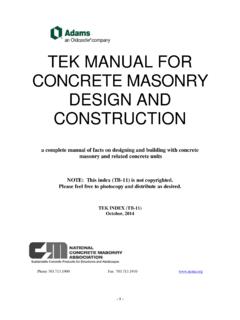Transcription of RADIANT CEILING PANELS - Sigma Convector …
1 SLC / SMC TECHNICAL CATALOG RADIANT CEILING PANELS | T. | F. MANUFA CTURE RS OF H YDRO NIC HEA TING A ND COO LING COMM ER CIA L & INDU STR IAL S I G M A R A D I A N T P A N E L S Y S T E M S | S L C / S M C | 3 TABLE OF CONTENTS PRODUCT OVERVIEW & DESIGN SLC LINEAR RADIANT CEILING 9 Unit Specifications ..10 Capacity Data ..12 Dimensions & Weights ..14 Pressure Drop Data ..15 Standard Shapes ..17 Installation Detail Diagrams ..19 Conceptual Renderings ..28 Guide Specifications ..42 SMC MODULAR RADIANT CEILING PANELS .. 45 Unit Specifications ..47 Capacity Data ..48 Dimensions & Weights ..50 Guide Specifications ..52 S I G M A R A D I A N T P A N E L S Y S T E M S | S L C / S M C | 5 PRODUCT OVERVIEW SLC | Sigma Linear CEILING PANELS Linear aluminum extruded PANELS with a castellated smooth face profile are available in a variety of widths and lengths to accommodate the perimeter planning of any building CEILING , including acoustic CEILING tile, drywall, or bulkhead CEILING types.
2 Panel widths are manufactured to fit into standard T-bar systems, and are also available with extruded T-frames for mounting into drywall or bulkhead CEILING applications. With an abundance of styles and configurations, a Sigma RADIANT Panel selection is sure to meet both the design needs of architects and performance needs of the mechanical engineer. Performance data for RADIANT hydronic heating PANELS has been verified by independent testing at the University of Waterloo in Ontario, Canada. Standard finish is textured white to match angle/tee mouldings normally used for acoustic CEILING tile type installations. Custom finishes are available, and modular PANELS can also be silkscreened to simulate acoustic CEILING tile patterns.
3 SMC | Sigma Modular CEILING PANELS Modular drop-in PANELS are available in standard 2 x 2 and 2 x 4 sizes, as well as custom sizes, for easy mounting into new or existing CEILING grids. Like the sun, RADIANT PANELS transfer energy directly to any surface the panel sees , much the same way that the sunshine illuminates a room. The uniformity of temperatures comes from the natural absorption and re-radiation of energy between all interior surfaces. RADIANT heat travels in straight lines until it reaches a solid object. The heat warms that object and is re-radiated to nearby colder objects. Unlike convective heat which is actually a current of warm air, RADIANT heat does not rise.
4 The floor is kept as warm as all other absorbing surfaces. Through this silent, non-mechanical process, RADIANT heating PANELS create a thermal barrier at the perimeter of the building providing a uniform draftless wall of warmth. This system provides an excellent integrated building heating/cooling design. The entire CEILING and all surfaces exposed to the RADIANT PANELS become part of the heating/cooling system by absorbing and re-radiating heat, providing a comfortable environment. BASIC PRINCIPLES SLC/SMC | SIGM A R ADIANT PANEL SY STEMS 6 | PRODUCT OVERVIEW Unlike conventional HVAC systems, RADIANT heating PANELS do not rely on room temperature.
5 The critical design parameter is the difference between the mean panel temperature and the average unheated temperature of all surfaces within the space. If the average unheated surface temperature (AUST) and the temperature of the air in a room equals the mean panel temperature (MPT), there will be no net heat transfer. When the AUST falls below the MPT, the PANELS radiate energy into the room. The energy radiated does not directly warm the air, but rather warms the glass/walls/furniture/floors and people inside of the room. These objects in turn warm the air. The mean RADIANT temperature within a space is one of the most important factors influencing occupant comfort.
6 Sigma RADIANT PANELS affect the mean RADIANT temperature directly by raising the surface temperatures in the space, and thereby providing occupants with superior control of ambient conditions. DESIGN CONSIDERATIONS RADIANT heating design is similar to that of conventional hydronic heating systems. Zone thermostats supply hot water to PANELS that respond instantaneously to give the space the necessary heating. Piping is located in the CEILING plenum which is usually readily accessible. As the PANELS raise the Mean RADIANT Temperature in the space, they make occupants more comfortable at ambient temperatures lower than those required of convective systems.
7 Consequently, Sigma recommends an inside dry bulb temperature 3 to 4 Deg F below that normally used with convective systems. Room loads should be calculated in the normal manner, using the ASHRAE guide. Calculations based on excessive factor of safety room loads should not be used, because such assumptions result in excessive panel width being specified. Using too wide a panel for the application reduces both effectiveness and efficiency of the system. Sigma utilizes 5/8 OD (1 2 nominal) copper tube, allowing for the use of standard plumbing fittings. All U-bends and spiral panel interconnectors (to connect multi-panel circuits together) are expanded so that no couplers are required.
8 Access PANELS are easy to specify, and are essentially separate, removable, RADIANT PANELS with no copper. This provides the installer and owner a means to access the hot water supply and hot water return connections in drywall or bulkhead CEILING configurations. To properly access a given CEILING , Sigma recommends that access PANELS be at least 12 inches long. Note that designers should account for heating capacity reduction due to access panel insertion into a building design. For example, if the wall to wall dimension of a room is 10 feet, and an 18 long access panel is used, then the maximum active copper length is reduced from 10 Feet to Feet.
9 If the room requires 4000 Btuh of heat, then the panel must supply 4000 feet = 471 Btuh/lineal feet. For the room with an acoustic CEILING tile-type CEILING , and no access panel, only 400 Btuh/lineal feet is required. Once the Btuh/lineal feet is correctly established, use the capacity charts to ascertain the specific Sigma RADIANT panel that works for you. DESIGN EXAMPLE (A) Determine the heat loss Calculate the realistic heat loss of the perimeter using standard ASHRAE methods. As explained above, do not use excessive safety factors. In this design example we shall use a heat loss of 8500 Btuh. (B) Determine the available length of panel per zone RADIANT heating PANELS should run continuously along the perimeter of a room or area.
10 Sometimes obstructions such as building columns, partition walls, or changes in direction influence the available length of active panel ( panel where copper can be installed). Typical column spacings in buildings are 20 to 30 feet. Generally, using the longest panel length is most economical and efficient. Bear in mind, however, that while Sigma can produce PANELS up to 14 feet long, these are extremely awkward to handle (especially for widths over 24 ). Both the Sigma factory and, more S I G M A R A D I A N T P A N E L S Y S T E M S | S L C / S M C | 7 importantly, the jobsite installation personnel will have issues with bowing and weight.









